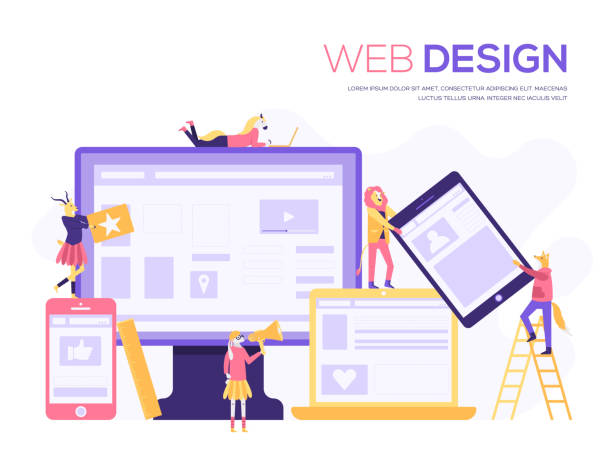What is Responsive Website Design and Why is it Crucial Today?

In the current digital age, where the diversity of user devices, from smartphones to tablets and desktops, has reached its peak, the concept of #Responsive_Web_Design is no longer a luxury option but an undeniable necessity.
This approach in web design enables websites to automatically adjust their layout and elements regardless of the screen size or type of device the user is employing, providing an optimal and integrated user experience.
The primary goal of responsive website design is to ensure content accessibility and readability on any platform.
In other words, a website with responsive design acts like a fluid that takes the shape of its container, displaying information in a suitable and usable format.
This educational and explanatory approach is the foundation of every successful web project in today’s world.
The importance of responsive website design is not limited to visual aesthetics; it directly impacts SEO (Search Engine Optimization), conversion rates, and overall user satisfaction.
Major search engines like Google give higher scores in search results rankings to websites that offer a mobile-friendly experience.
This means that if your website is not optimized for display on various devices, you might lose many potential visitors.
In fact, many businesses have found that a significant portion of their web traffic comes from mobile devices; therefore, investing in a responsive design is not just an investment for the future but an urgent need to remain competitive in the digital market.
This is a specialized topic that every webmaster should pay attention to.
Furthermore, User Experience (UX) significantly improves with responsive website design.
When users don’t need to zoom, horizontal scroll, or resize the window to view content, they will feel more satisfied and are more likely to stay on your website and interact with it.
This leads to a decrease in bounce rate and an increase in time spent on the site, both of which are positive signals for search engines.
Finally, maintaining a responsive website is also simpler; instead of developing separate versions for desktop and mobile, only one codebase is maintained, which reduces development costs and time.
This approach prepares the website for any type of news or content and ensures that the audience can easily access information.
Does your company’s website create a professional and lasting first impression in the minds of potential customers? Rasaweb, with its professional corporate website design, not only represents your brand’s credibility but also opens a path for your business growth.
✅ Create a powerful and reliable brand image
✅ Attract target customers and increase sales
⚡ Get free consultation
Technical Aspects of Responsive Design: Media Queries and Flexible Grids

Behind every successful responsive website design lie key technical concepts such as Media Queries, Flexible Grids, and Fluid Images.
Media queries allow web designers to apply different CSS rules based on user device characteristics such as screen width, height, orientation, and resolution.
This CSS3 feature is the heart and soul of a responsive design and allows the website to change its behavior based on the environment in which it is displayed.
For example, it can be specified that on small screens, columns stack instead of appearing side-by-side, or fonts become larger to improve readability.
This is a purely specialized and analytical part of the development process.
Flexible grids, often built using relative units like percentages (%) instead of fixed pixel (px) units, ensure that the website’s layout is scalable with screen size changes.
Instead of defining fixed widths for columns, relative percentages are used so that the width of each element dynamically adjusts to the overall width of its parent container.
This approach is essential for creating a responsive website, as it allows content to naturally fit into different spaces and prevents horizontal scrolling.
Furthermore, fluid images, by using CSS and setting the `max-width: 100%` property, ensure that images never overflow their container and scale up or down to fit the available space.
This combination of techniques forms the foundation of a strong and sustainable responsive website design.
Implementing these technical aspects requires a deep understanding of CSS and HTML.
The use of CSS preprocessors like Sass or Less can also help manage styling complexities in large projects and make coding more organized and efficient.
These techniques form the backbone of a professional responsive website design, allowing developers to build websites that look great and perform flawlessly on any device.
This part of the technical discussions continuously evolves with new CSS updates like CSS Grid and Flexbox, providing developers with more powerful tools to implement complex and flexible layouts.
This is a specialized and in-depth topic that every web developer should master.
Benefits of Responsive Website Design for SEO and User Experience

Responsive website design is more than just a simple design trend; it is a vital strategy that directly impacts the online success of businesses.
One of the biggest advantages of this approach is a significant improvement in SEO (Search Engine Optimization).
Google and other search engines prefer websites that provide a good user experience on mobile devices.
By having a responsive website, you maintain only one version of your website for all devices.
This means a single URL, a single codebase, and a significant reduction in duplicate content issues.
This approach makes it easier for search engine crawlers to index and rank your content.
This is an important analytical and explanatory advantage that directly affects your website’s visibility.
News regarding Google’s algorithm updates consistently emphasizes the importance of mobile-first.
In addition to SEO, User Experience (UX) also benefits from a responsive website design.
Today’s users expect websites to be easy to use regardless of their device.
If your website does not display correctly on mobile, users will quickly leave it and go to competitors.
A responsive design ensures that your visitors do not need to zoom, horizontal scroll, or complex navigation.
Buttons and links are large enough and forms display correctly, all of which contribute to increasing user satisfaction and reducing bounce rate.
Low bounce rates and high dwell times send positive signals to search engines and can help improve your ranking.
This indicates that your content is engaging and useful for users.
This is very important guidance for any online business.
Below, a comparison table is provided that summarizes the key benefits of responsive website design:
| Feature | Benefit | Further Explanation |
|---|---|---|
| Improved SEO | Higher ranking in search results | Google prefers mobile-friendly websites, single URL, reduced duplicate content. |
| Better User Experience | Increased user satisfaction and engagement | Adaptive design for any device, easy navigation, reduced bounce rate. |
| Reduced Maintenance Costs | One codebase for all platforms | Only one website needs development and maintenance, saving time and resources. |
| Increased Conversion Rate | More successful online business | Easier and more convenient access to information and products, encouraging action. |
| Future Compatibility | Preparation for new devices | Flexible design easily adapts to new devices and screen sizes. |
These benefits demonstrate that responsive website design is not only a smart investment but also a strategic necessity for any entity or business seeking sustainable success in the online space.
This is not a question-provoking content, but a definitive answer to the challenges of the digital world.
Popular Tools and Frameworks for Implementing Responsive Design

Implementing a responsive website design has become much simpler than before, thanks to the powerful tools and frameworks available to developers today.
These tools not only accelerate the development process but also help ensure the compatibility and proper functioning of the website across a wide range of devices.
One of the most well-known and widely used frameworks is Bootstrap.
Bootstrap is an HTML, CSS, and JavaScript framework designed for rapid development of responsive and mobile-first websites.
With its 12-column grid system and ready-made UI components, Bootstrap allows developers to create beautiful and fully responsive websites without needing to write CSS from scratch.
This is an unparalleled educational and specialized tool.
Alongside Bootstrap, native CSS technologies such as Flexbox (Flexible Box Layout module) and CSS Grid (CSS Grid system) also play a pivotal role in responsive website design.
Flexbox is a one-dimensional layout model that is highly efficient for distributing space within a row or column and is used for aligning and distributing items within a container.
CSS Grid, on the other hand, is a two-dimensional layout model that provides more precise control over rows and columns and is excellent for designing more complex and overall web page layouts.
The combination of these two gives developers unparalleled power to create fully flexible and responsive layouts.
These approaches are valuable guidelines for modern design.
Other useful tools for responsive development include CSS preprocessors like Sass and Less, which help organize and manage CSS styles in large projects.
Additionally, responsive testing tools in browsers (such as Responsive Design Mode in Chrome DevTools or Firefox Developer Tools) allow developers to quickly simulate and examine how their website appears on different screen sizes.
The choice of the right tool depends on project needs and developer preferences, but a clever combination of these frameworks and techniques can significantly improve the responsive website design process and deliver higher quality results.
This specialized approach not only reduces development time but also helps maintain standards and quality, making it highly suitable for analytical and explanatory content.
New developments always introduce better tools in this area.
Is your e-commerce site ready to attract maximum customers and increase sales?
Rasaweb revolutionizes your online business with modern and efficient e-commerce website designs!✅ Increased speed and improved SEO
✅ Excellent user experience on mobile and desktop⚡ Get a free e-commerce website design consultation from Rasaweb!
Common Challenges and Issues in Responsive Website Development

Although responsive website design offers countless benefits, its development process also comes with challenges and issues that developers should be aware of.
One of the main challenges is content and image management across different screen sizes.
Large images can slow down website loading and create a poor user experience, especially on mobile devices with limited internet connectivity.
To solve this problem, techniques such as “Responsive Images” using the <picture> tag or `srcset` and `sizes` attributes have been introduced, which allow the browser to select the best image size based on the user’s device.
This is a challenging content that requires specialized solutions.
Another challenge relates to website Performance.
A responsive website design that is not well-optimized can be slow on mobile devices.
This includes loading excessive CSS and JavaScript that are not necessary for all devices.
To counter this, strategies such as Conditional Loading of resources or using the Mobile-First approach, where the design is first for small devices and then capabilities are added for larger devices, are essential.
Also, code compression, caching, and server optimization are crucial to ensure proper loading speed on any device.
This is an in-depth explanation of technical challenges.
Moreover, testing and debugging responsive websites can be complex.
With countless devices and screen sizes, ensuring the website displays correctly on all of them is difficult.
Browser simulation tools are useful, but actual testing on physical devices is essential to identify potential issues.
Navigation and touch interactions can also be challenging; buttons and menus must be large enough to be easily tapped with a finger and prevent “accidental touches.”
These specialized issues require high precision and experience in the design and development process of responsive websites.
Solving these challenges requires deep knowledge and an analytical approach for each project.
New developments in testing tools can also help in this area.
The Future of Responsive Design: Beyond Devices and Adaptability Concepts

The future of responsive website design goes beyond merely reacting to screen size and is moving towards Adaptive Design and even Ambient Computing.
While responsive design means a single design that scales everywhere, adaptive design means creating multiple fixed layouts that are loaded based on specific device characteristics (such as screen size or device type).
This approach can offer more control over the user experience on specific devices and help optimize performance on those devices.
This is an analytical topic that is constantly evolving, with new developments being published daily.
Furthermore, the concept of “User-First” is emerging instead of “Mobile-First”.
This means focusing on the user’s needs and behavior, regardless of the device they are using.
This includes considering device sensors, location, connection speed, and even battery level to provide a truly personalized experience.
For example, a website might automatically load lower-quality images or display less content if a slow internet connection is detected.
These developments represent a more comprehensive and intelligent approach to responsive website design, operating beyond the physical dimensions of the screen and responding to the user’s environmental conditions.
This is a specialized approach that requires a deep understanding of human-computer interaction.
With the advent of technologies such as Augmented Reality (AR), Virtual Reality (VR), and the Internet of Things (IoT), responsive website design must adapt to new interactive platforms.
This means that websites not only need to look good on screens but also need to function properly on voice UIs, holographic interfaces, or even wearable devices.
This is a future where websites must be able to react to various sensory inputs and deliver content in an entirely new and rich manner.
These developments drive web developers towards creative and innovative thinking in the field of adaptive design.
This is a thought-provoking content for the future, yet at the same time very engaging and educational.
Mobile-First Approach: Importance and Implementation

In today’s world, where most users connect to the internet via mobile devices, adopting a Mobile-First approach in responsive website design is a vital and intelligent strategy.
This approach means that designers and developers should first design and code the website for small screens (mobile) and then gradually add features and details for larger screens (tablet and desktop).
This is contrary to the traditional “Desktop-First” approach, where the website was first designed for desktop and then scaled down for mobile.
The importance of mobile-first is not only due to prioritizing the mobile user experience but also directly impacts SEO and website performance.
How to implement the Mobile-First approach includes the following steps: First, schematic design and wireframing should begin for the smallest screens.
At this stage, only the most essential content and functionalities are included to prevent overload and clutter on mobile devices.
Then, using CSS media queries that operate bottom-up (min-width), styles are gradually added for larger screen sizes.
This means that base styles are defined for mobile, and then CSS rules for tablets and desktops are progressively added to improve the layout and appearance of the website.
This is specialized and practical guidance that develops a responsive website in the best possible way.
The main advantages of Mobile-First include improved performance, especially on mobile devices, as only essential CSS and JS for small screens are loaded.
Additionally, this approach simplifies the design process, as designers are forced to focus on core content and functionality.
This leads to a better user experience on mobile, which Google highly values and incorporates into its ranking algorithms.
Below is a comparative table between Mobile-First and Desktop-First approaches:
| Feature | Mobile-First Approach | Desktop-First Approach (Traditional) |
|---|---|---|
| Design Starting Point | Smallest screen (Mobile) | Largest screen (Desktop) |
| Media Queries | `min-width` (from small to large) | `max-width` (from large to small) |
| Mobile Performance | Optimized, faster | May be slow, loads additional resources |
| SEO | Google’s preference, better ranking | May be less favored |
| Design Focus | Core content and functionality | More details and visual elements |
Choosing the Mobile-First approach for responsive website design is not only a logical choice but also essential for the long-term success of a website in today’s digital ecosystem.
This is an educational and analytical content that all developers are advised to take seriously.
Industry news also constantly points to this issue.
Performance Optimization in Responsive Websites

Performance Optimization is one of the crucial aspects in the development of responsive website design.
Regardless of how good your website looks on various devices, if its loading is slow, users will quickly become frustrated.
Website loading speed not only affects user experience but is also an important factor in SEO ranking by search engines.
In responsive websites, this challenge becomes more complex, as it must be ensured that the website performs well on different devices with varying processing capabilities and internet speeds.
This is a specialized and analytical topic that requires special attention.
One of the main techniques for performance optimization in responsive website design is image optimization.
Images are often the biggest cause of slowness on websites.
Using appropriate image formats (like WebP for better compression), compressing images without significant loss of quality, and employing the Lazy Loading technique, where images are only loaded when they are visible in the user’s viewport, can significantly increase loading speed.
Additionally, using `srcset` and `sizes` attributes in the `` tag allows the browser to select the most appropriate image size based on the user’s device, which prevents loading unnecessarily large images.
These guidelines significantly help improve the user experience.
Other important strategies for performance improvement include compressing and minifying CSS and JavaScript files to reduce their size.
Removing unnecessary code and comments, as well as combining multiple CSS and JS files into fewer files, can reduce the number of HTTP requests.
Using Browser Caching and Content Delivery Networks (CDNs) can also increase the speed of content delivery to users worldwide.
CDNs store your website’s static content on servers around the world, so when a user accesses your website, the content is delivered from the server closest to them.
This is a technical tutorial to achieve optimal performance.
Adhering to these specialized tips in responsive website design ensures that users have a fast and smooth experience on any device, which in turn leads to increased engagement and conversion rates.
Recent news in the realm of Google’s Core Web Vitals has further highlighted the importance of these optimizations.
Does your current e-commerce website design lead to losing customers and sales?
Rasaweb is your solution with modern and user-friendly e-commerce website designs!
✅ Significant increase in conversion rates and sales
✅ Strong branding and building customer trust
⚡ Get a free e-commerce website design consultation from Rasaweb!
Continuous Testing and Optimization in Responsive Design

After implementing responsive website design, continuous testing and optimization are essential to ensure the flawless performance of the website over time.
The world of devices and browsers is rapidly changing, and what works well today might need adjustment tomorrow.
Manual testing on actual devices (various mobiles, tablets, and desktop sizes) is crucial for identifying issues related to touch interaction, font display, and layouts.
These tests should complement browser simulation tools, as simulators cannot reproduce all details of the user experience on a real device.
This is a very important educational topic and guide for every developer.
In addition to manual testing, using automated testing tools can also help identify issues more quickly.
Tools like Google PageSpeed Insights, Google Mobile-Friendly Test, and Lighthouse can provide valuable insights into performance, accessibility, and compliance with mobile-first standards.
These tools identify weaknesses and offer suggestions for improvement, which can be very useful in the responsive website design optimization process.
Monitoring Google Analytics data can also provide information about the devices users are using, bounce rates by device, and dwell time, all of which can help identify areas for improvement.
This is an analytical and specialized process that must be carried out continuously.
Another key aspect of continuous optimization is listening to user feedback.
Surveys, feedback forms, and even social media can be valuable sources of information about user problems or dissatisfactions on specific devices.
By collecting this feedback and implementing necessary changes, you can continuously improve the user experience and ensure that your responsive website design is always at its best.
This continuous cycle of testing, analysis, and optimization is essential for maintaining competitiveness and providing an excellent user experience in the changing digital world.
This is not a question-provoking content, but a way to maintain the quality and performance of your website.
The Importance of Content in Responsive Design: Content Strategies

In responsive website design, content is not only king, but it must also act intelligently.
The content strategy in a responsive website differs from traditional websites because it must ensure that content remains readable, accessible, and engaging on any screen size.
One of the first steps in this regard is to focus on core and essential content.
On mobile devices, screen space is limited, so it must be ensured that the most important information is accessible and visible without the user needing to scroll excessively or search deeply.
This is a specialized and analytical topic that directly impacts user experience.
Furthermore, content formatting is crucial for readability on various devices.
Using short paragraphs, bulleted lists, clear subheadings, and sufficient white space can make content easier to read on small screens.
Images and videos should be optimized and responsive, so they load quickly and resize to fit the screen size.
Avoiding Flash content and using modern formats like HTML5 for video and animation is also essential, as many mobile devices do not support Flash.
These guidelines are vital for creating an excellent user experience on any platform.
The “Content First” approach in responsive website design means that content should be considered before visual and graphic design.
This ensures that the structure and organization of the content are logical and usable, even before styles are applied.
This approach helps designers and developers make better decisions about layout and UI elements, as the primary goal is effective content delivery.
Also, Call to Action (CTA) messages should be clearly visible and tappable, especially on mobile devices, so users can easily perform desired actions.
This includes larger buttons and appropriate spacing between interactive elements.
This is a comprehensive and practical tutorial that directly impacts your online business conversion rate.
News regarding the importance of user-friendly content in Google’s ranking makes this topic even more critical.
Frequently Asked Questions
| Question | Answer |
|---|---|
| What is Responsive Web Design? | It is a method for designing and implementing websites that allows the layout and content of the page to automatically adjust and display optimally based on the user’s device screen size (desktop, tablet, mobile, etc.). |
| Why is responsive design important? | With the increasing use of various devices to access the web, a responsive site improves user experience, reduces bounce rate, strengthens site SEO, and makes site management and maintenance easier (instead of having separate versions for mobile and desktop). |
| How does responsive design work? | This type of design uses techniques such as flexible grids and layouts (Flexbox, CSS Grid), flexible images and media, and most importantly, CSS Media Queries to change the styles and layout of the page based on screen characteristics (width, height, resolution, etc.). |
| What are the main tools for implementing responsive design? | The main tools include HTML5 (for content structure), CSS3 (especially Media Queries, Flexbox, Grid for styling and responsive layout), and sometimes JavaScript for more complex interactions. |
| What are the main benefits of using responsive design? | The main benefits include increased user accessibility (covering a wide range of devices), improved user experience, better site ranking in search engines (especially Google), reduced development and maintenance costs, and increased visitor-to-customer conversion rates. |
And other advertising services of Rasaweb Advertising Agency:
Smart Customer Journey Map: Designed for businesses seeking to analyze customer behavior through engaging UI design.
Smart Link Building: An innovative service to enhance campaign management through marketing automation.
Smart Digital Branding: A combination of creativity and technology to increase click-through rates by customizing user experience.
Smart Brand Identity: An innovative service to increase click-through rates through precise audience targeting.
Smart SEO: Designed for businesses looking for digital branding through Google Ads management.
And over hundreds of other services in internet advertising, advertising consultation, and organizational solutions.
Internet Advertising | Advertising Strategy | Advertorial
Resources
Digital Transformation GuideResponsive Website Design TutorialWeb Design Trends in the New YearWhy is Responsive Design Essential?
❓ To be seen and lead in the digital world, Rasaweb Afarin Digital Marketing Agency is with you. We elevate your business by providing comprehensive services including personal website design, SEO, and social media management.
📍 Tehran, Mirdamad Street, next to Bank Markazi, Southern Kazeroon Alley, Ramin Alley, No. 6

